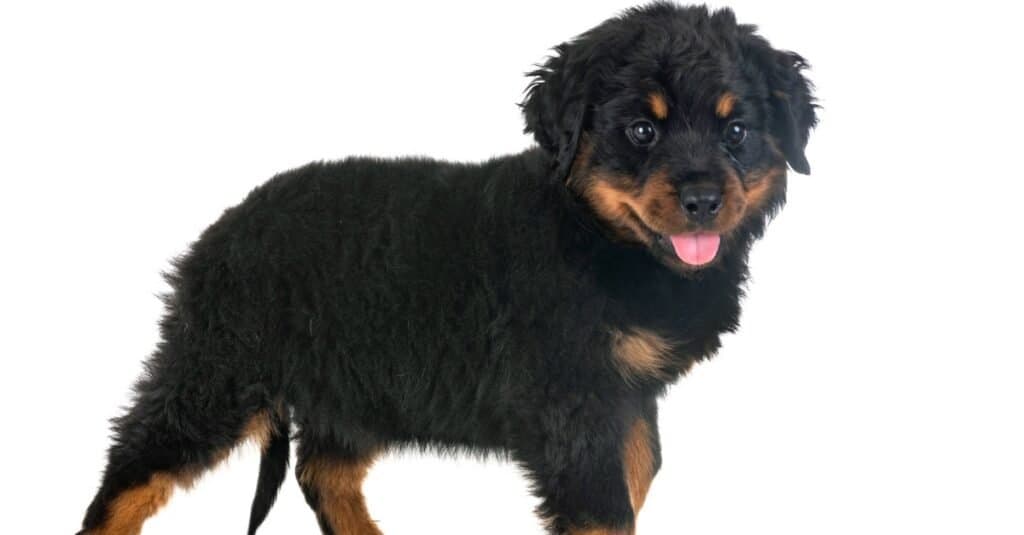Long-Haired Rottweiler
Canis lupus
Rottweilers have a tendency to snore.
Advertisement
Long-Haired Rottweiler Scientific Classification
- Kingdom
- Animalia
- Phylum
- Chordata
- Class
- Mammalia
- Order
- Carnivora
- Family
- Canidae
- Genus
- Canis
- Scientific Name
- Canis lupus
Read our Complete Guide to Classification of Animals.
Long-Haired Rottweiler Conservation Status
Long-Haired Rottweiler Facts
- Name Of Young
- puppy
- Fun Fact
- Rottweilers have a tendency to snore.
- Temperament
- Loyal, affectionate, confident, and fearless
- Litter Size
- 6-12 puppies
Long-Haired Rottweiler as a Pet:
- General Health
- Energy Level
- Shedability
- Trainability
- Intelligence
- Tendency to Chew
- Size
- Family and kid friendliness
- Yappiness / Barking
- Low
- Separation Anxiety
- Moderate
- Preferred Temperature
- Average climate
- Exercise Needs
- High
- Friendly With Other Dogs
- Moderate
- Pure bred cost to own
- $1,500+
- Dog group
- Working
- Male weight
- - lbs
- Female weight
- - lbs
This post may contain affiliate links to our partners like Chewy, Amazon, and others. Purchasing through these helps us further the A-Z Animals mission to educate about the world's species.
View all of the Long-Haired Rottweiler images!
The ancestor of the Rottweiler would march over the Alps with Roman legions to protect them and drive their cattle.

The Rottweiler is a strong, muscular working breed that descended from big mastiff-like dogs back in the Roman period. They were originally put to use herding livestock, pulling carts, and protecting their owners. The modern version of this breed was developed in Germany following the end of the Roman Empire. Today it is still prized as a guard dog, police dog, search and rescue dog, and overall companion.
See all of our expert product reviews.
As the name suggests, the long-haired Rottweiler has a much longer coat of fur than what’s normally accepted for this breed. It is characterized by a strong muzzle, drooping ears, and a curved medium-length tail. The long, thick double coat of fur comes in black and tan/mahogany. Tail docking was once common, but it’s now banned in many countries. The bobbed tail and other deviations are usually disqualifying traits.
Long-Haired vs. Short-Haired
The long-haired Rottweiler is the same as the short-haired Rottweiler in every respect except for its longer hair. Unfortunately, because short hair is an important part of the breed standard, the long-haired dog isn’t normally accepted as a “true” Rottweiler. Many breeders do not favor them at all and won’t sell them, so they’re quite rare. A long-haired Rottweiler will sometimes still arise because of a genetic change; it’s also produced when two long-haired parents breed together.
There’s a common misconception that the long-haired version is a mix, but it’s not. This is a purebred Rottweiler, just with longer hair. No other breeds are mixed in.
Types of Rottweiler
You may hear that there are three types of Rottweiler: American, German, and Roman. That is not exactly true. The differences between the American and German Rottweilers are minor: One is born in America, the other in Germany; The American has a docked tail, the German’s is kept naturally long. The German breeding standards are stricter.
The Roman Rottweiler is not a recognized type. It is often a mixed breed dog (usually with a mastiff) bred to be abnormally large, which can bring about all kinds of health problems.
Health and Entertainment for your Long-Haired Rottweiler
- The Best Wet Food for Senior Dogs
- The Best Dog Food for Labrador Retrievers (Senior, Puppy, and Adult)
- These Are the Best Probiotics for Dogs (They Actually Work)
- Victor Senior Healthy Weight Dog Food Review: Recalls, Pros, Cons, and More
- The Best Dog Food for Small Dogs (Puppy, Adult, Senior): Ranked and Reviewed
See all of our expert product reviews.

The only difference between the long-haired and short-haired Rottweilers is the length of their coat.
©iStock.com/cynoclub
3 Pros and Cons of Ownership
| Pros | Cons |
|---|---|
| Affectionate with the Family: This dog loves to interact with its owner. | Territorial: The Rottweiler can sometimes become aggressive toward strangers. |
| Highly Trainable: The Rottweiler is one of the most trainable of all dog breeds in the world. | Needs a Lot of Activities: Owners should prepare to spend a lot of time on exercise, games, and other activities. |
| Intelligent and Hard-working: The Rottweiler has an exceptionally keen mind and needs frequent activities. | Health Problems: The Rottweiler has a slightly below average lifespan and several health problems associated with larger dogs. |
Size and Weight
The Rottweiler is a very large dog with a big, muscular body. Males tend to weigh significantly more than females.
| Weight (Male): | 95-135 pounds |
| Weight (Female): | 80-100 pounds |
| Height (Male): | 24-27 inches |
| Height (Female): | 22-25 inches |
Common Health Issues
The long-haired Rottweiler is just as healthy as the short-haired version. There are no additional known health problems associated with the long-haired trait that you need to worry about beyond the standard health conditions. These can include allergies, hypothyroidism, aortic stenosis (a heart defect caused by a narrowing aorta), and hip and elbow dysplasia in which the bone can become loose from the socket. Another significant issue is bloating. This is a life-threatening condition that can occur in big-chested breeds when gas builds up in the stomach; symptoms can include excessive salivating, retching or vomiting, a bloated abdomen, and a rapid heartbeat. Immediate medical attention is necessary.
Cancer (especially an aggressive form that affects the bones) is also a leading cause of death in this breed. Unfortunately, even in good circumstances, this dog has a below-average life expectancy of nine to ten years, but there are a few things you can do to improve your dog’s health. First, make sure it has had a thorough medical evaluation, preferably done by the breeder (a positive test for dysplasia is a huge red flag). Second, it needs a full set of vaccinations as soon as possible. Finally, develop a relationship with your vet and stick to a regular appointment schedule. In summation, these are the most common health problems of the Rottweiler:
- Allergies
- Hypothyroidism
- Bloating
- Cancer
- Hip and elbow dysplasia
Temperament
Despite its somewhat unfair reputation as a difficult breed, the Rottweiler is a very affectionate and gentle member of the family and an incredibly hard worker. It can be playful, goofy, and even surprisingly cuddly. The problem comes when its protective instincts start to become highly territorial and aggressive toward strangers. Fortunately, with proper training, this protective behavior can be channeled toward more positive pursuits.
Games, sports, exercise, and activities should all be planned out in advance to keep your dog entertained and occupied. It will need plenty of socialization as well. Keep in mind this is a purebred Rottweiler, not a mix, so expect a typical Rottweiler personality.
Care
Except for a bit of extra grooming, the long-haired Rottweiler should require no more time to care for than the short-haired version. Unfortunately, it is a bit of a high-maintenance dog with lots of special considerations you need to account for. This breed is not a good choices for inexperienced owners.
Best Dog Food
The Rottweiler will probably need, at a minimum, four cups of high-quality dry food per day; the exact amount will depend on its size and activity level. Unfortunately, this breed has several special dietary issues. First, the Rottweiler does suffer from food allergies; since it can be anything from beef to grain, you may need to eliminate foods slowly from the diet to find the right culprit. Talk with your vet to make sure.
Second, this breed does tend to gain weight, so try to limit its calorie intake if it appears to be putting on pounds. Third, because it suffers from bloating, it should eat two or more smaller meals rather than one big meal per day. Finally, stay informed about this breed’s risk of the heart condition aortic stenosis, and stay away from legumes in itsir diet, since legumes like peas and lentils are linked to heart failure in dogs.
A-Z Animals believes the best dog food for Long-Haired Rottweilers is Stella & Chewy’s Wild Red Classic Kibble Dry Dog Food.
This legume-free kibble with protein from duck, turkey, and chicken also excludes the common filler ingredients that can induce allergic reactions and food sensitivities. There’s healthy fiber for digestive support, glucosamine for resilient joints, and taurine to keep your dog’s heart in tip-top shape.
Stella and Chewy’s Wild Red Classic Kibble is available on Chewy and Amazon.
- Packed full of protein with beef, pork, and lamb
- Crafted without legumes or poultry
- 81% of protein is from actual animal sources
- "Whole prey” ingredients including muscle meat, organ meat, and cartilage
- No fillers, artificial colors, artificial flavors, or preservatives.
Maintenance and Grooming
Because of its long coat, the long-haired Rottweiler will probably require a bit more brushing and trimming than the short-haired version. You may need to brush the coat a few times a week and bathe it regularly to remove loose hair and dirt and keep the coat looking clean and healthy. Brushing may need to occur more frequently in the spring and fall shedding seasons, perhaps once a day. Owners will also need to trim the nails weekly with a grinding tool to prevent discomfort and pain. Check the ears regularly for signs of infection or obstruction. Finally, brush the teeth weekly with a plan approved by your vet to improve oral hygiene.
Training
As an intelligent working breed, the Rottweiler is highly obedient and trainable. It will benefit greatly from a clear and consistent training structure with proper leadership. You should assert this leadership early on and act with firmness to guide the dog toward your desired outcome. Contrary to some widely used practices, however, you should not treat this breed in a harsh or disciplinary manner.
Exercise
The Rottweiler will probably need at least an hour of exercise every day (though individuals can vary). As a strong and athletic breed, it appreciates long walks, swimming, and hiking. It also excels at herding, tracking, and obedience challenges. Give it a job to do and it will be very happy and content.
Puppies

Rottweiler puppies take a while to grow into their bodies, so strenuous exercise should be limited until their bones and joints are strong.
©iStock.com/cynoclub
Rottweiler puppies will require very thorough socialization from an early age. Frequent exposure to new people and situations can help puppies adjust properly to adulthood. Classes and crate training can also help with some behavioral issues. Another thing to keep in mind with many large dogs is that they take a while to grow into their bodies. Strenuous exercise, especially on hard surfaces, should probably be limited until it has properly matured. In worst cases, the puppy can sometimes suffer from panosteitis, or growing pains, when the bones can become inflamed and painful.
If you have any other questions about vaccines or micro-chipping, then you should talk with your vet.
Children
The Rottweiler should get along well with most children, especially if raised with them from an early age. It is an affectionate, loyal, and highly protective breed. However, the dog will need to be taught how it should act around kids. Its enormous size could be a problem for younger children in particular.
Similar Dogs
- Bullmastiff: Originally created in 19th century England to guard estates, the Bullmastiff is a big, powerful breed, potentially weighing up to 130 pounds. Despite its enormous size, it is a very well-behaved member of the family with a bit of a sensitive side. The short and weather-resistant coat comes in brindle, red, or fawn with a black mask.
- American Bulldog: A descendent of the Old English Bulldog, this breed proved to be useful as an all-around working dog on the farm. Big, strong, and tough, weighing up to 125 pounds, the American Bulldog bonds very deeply with its owner, but it’s equally as distrustful and wary of strangers, making it a good watchdog. It is characterized by short, rough white hair with darker patches.
- English Mastiff: Dating at least as far back as the Classical Period, this working breed and guardian was later developed and refined in English. It is a true behemoth, potentially weighing up to 230 pounds. Surprisingly gentle and loving, this breed has a smooth apricot or fawn coat with a black mask.
Famous
The breed, as a whole, is very well-known. Will Smith, Leonardo DiCaprio, and Bruno Mars have all owned a long-haired rottweiler. It’s also appeared in many films, including “Ferris Bueller’s Day Off.”
Popular Names
Here are a few suggestions for appropriate Rottweiler names:
- Harley
- Roxy
- Bear
- Max
- Zeus
- Zoe
- Charlie
- Bear
- Luna
- Bella
Long-Haired Rottweiler FAQs (Frequently Asked Questions)
How much does a long haired Rottweiler cost?
The price of a new long-haired Rottweiler puppy from a trustworthy breeder could be $1,500 or more, in addition to the price of toys, food, vet appointments, classes, etc. These are relatively rare dogs, and many Rottweiler breeders simply won’t sell them, because they don’t conform to breed standards. Your best bet is to find a highly specialized breeder, one who breeds long-haired Rottweilers specifically, but you might have to do the hard work of tracking them down yourself. Fortunately, some Rottweiler rescues may offer these rare dogs for adoption. The price of adoption is usually no more than a few hundred dollars. An adoption dog may have some behavioral issues and take extra time to train, however.
What is the temperament of a long haired Rottweiler?
The long-haired Rottweiler is loyal, affectionate, and devoted toward its owner. It’s also a hard-working breed and a confident and fearless guardian. But it also has a reputation for being very distrustful and wary of strangers. If not properly trained, this can find an outlet in aggressive behavior. Make sure it has received all of the proper training and socialization as a puppy.
Thank you for reading! Have some feedback for us? Contact the AZ Animals editorial team.
Sources
- Rottweiler Life, Available here: https://www.rottweilerlife.com/long-haired-rottweiler/
- American Kennel Club, Available here: https://www.akc.org/dog-breeds/rottweiler/
- dogtime.com (1970) https://dogtime.com/dog-breeds/rottweiler#/slide/10 Jump to top


















